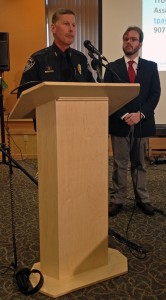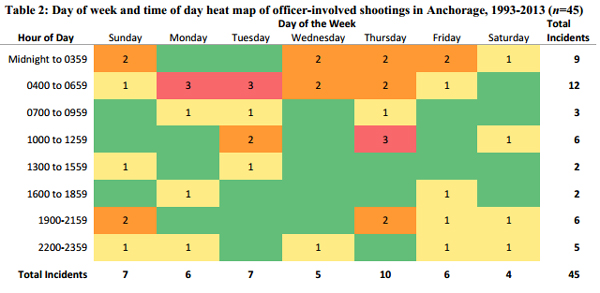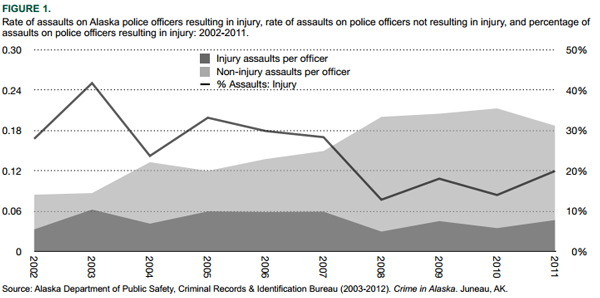Anchorage Police Chief Mark Mew and Dr. Troy Payne with the University of Anchorage Alaska Justice Center presented findings from a study about police shootings at UAA’s Gorsuch Commons today.
Chief Mew clarified how the demographics involved in shootings changed from the first decade of study to the second.

“The number of African Americans that we engage in and shoot at are going down, first half to the second half. Pacific Islanders coming up the first half to the second half. Hispanics, Natives are going down first half to the second half,” Mew said. “It seems to me that the data is all over the place, but the numbers are pretty small.”
The study of Anchorage police shootings over the past 20 years has produced conflicting data. Although minority citizens are disproportionately involved in police shootings the majority shot by officers were white. The study attempts to show the recipe for officer-involved shootings and says vehicles are used as weapons in many cases.
Although minority citizens are disproportionately involved in police shootings, the majority shot by officers were white.
The study attempts to show the recipe for officer-involved shootings and says vehicles are used as weapons in many cases.
After two years of high profile officer-involved shootings in Anchorage, including one of a Pacific Islander man armed only with a stick, the Anchorage Police Department commissioned the study from the University of Alaska Anchorage Justice Center.
Researchers caution the study deals with small numbers, just 45 shootings in two decades, and that much of the data is contradictory.
“We were looking at situational characteristics, officer characteristics and characteristics of the citizens that were involved in these,” Assistant Professor Dr. Troy Payne, who reviewed the cases, said.
Payne says minorities, particularly African Americans, Native Hawaiians and Pacific Islanders are disproportionately represented in officer-involved shootings over the 20 year period. And he says that’s not a surprise because minorities tend to be over represented when it comes to just about every aspect of the criminal justice system from arrest rates to the ability to get bail.
“I don’t see that as something that is suggestive that APD is racist or has any kind of racial animus, but it is a question and we should probably be looking at that,” Payne said. “It may very well be that people from these communities react different to the police and it may be that the police department can engage in training and outreach that could help address that; it may be that these communities need to think carefully about how they’re reacting to police officers operating in their neighborhood.”

Anchorage Police Chief Mark Mew says the department commissioned the study because of public outcry regarding the spike in officer involved shootings in recent years. There were five in 2012 and five more in 2013.
“Those two events back-to-back got the police department and the public and the media all talking about what, if anything, has changed in this town; what if anything is changed with the police department – and we committed to doing a number of things,” Mew said. “One of those things is to take a good hard look into what we think is going into these officer involved shootings: what we could learn, what kind of changes we could make, what kind of changes the public needs to make.”
Last spring, the police decided to stop firing at vehicles and to institute new tactics for dealing with cars when they’re being used as weapons. Mew says the study confirms that was the right choice, showing that in 40 percent of officer-involved shootings the weapon was a car.

A fact sheet recently produced by the UAA Justice center says assault on officers has gone up over the past decade in Alaska. And the shift in tactics at APD, he says, is an effort to address that. But Mew says, in general, it’s hard to get much clarity from the study.
“The data on one hand says that certain minorities are over represented. There’s other data that would suggest that minority officers shoot more. There’s other data that says that most of the people we shoot are white,” Mew said. “I mean the data is conflicting and the numbers are tiny and I think to try and draw sweeping conclusions based on that is taking issues out of context and I don’t want to see the community divided over that.”
Dr. Payne researched which minorities were shot most often during the first decade and found most were black males, but over the past 10 years that group has been replaced by Native Hawaiian and Pacific Islander males.
The family of Shane Tasi, the Pacific Islander man who was shot and killed while wielding a stick last year is suing the Anchorage Police Department. His is the only case over the 20-year period where someone was shot for using a blunt object as a deadly weapon.
Mew says another study is in the works that will look at cases in which officer-involved shootings did not happen. Both studies will be updated annually and eventually the APD will use the information to create further prevention strategies.
About one third of officer-involved shootings in the study resulted in citizen fatalities. A report by the Police Minority Task Force on police shootings is scheduled for publication later this month. The APD plans to, for the first time, to publish their policies, including those concerning officer-involved shootings, in 2014.
Daysha Eaton is a contributor with the Alaska Public Radio Network.
Daysha Eaton holds a B.A. from Evergreen State College, and a M.A. from the University of Southern California. Daysha got her start in radio at Seattle public radio stations, KPLU and KUOW. Before coming to KBBI, she was the News Director at KYUK in Bethel. She has also worked as the Southcentral Reporter for KSKA in Anchorage.
Daysha's work has appeared on NPR's "Morning Edition" and "All Things Considered", PRI's "The World" and "National Native News". She's happy to take assignments, and to get news tips, which are best sent via email.
Daysha became a journalist because she believes in the power of storytelling. Stories connect us and they help us make sense of our world. They shed light on injustice and they comfort us in troubled times. She got into public broadcasting because it seems to fulfill the intention of the 4th Estate and to most effectively apply the freedom of the press granted to us through the Constitution. She feels that public radio has a special way of moving people emotionally through sound, taking them to remote places, introducing them to people they would not otherwise meet and compelling them to think about issues they might ordinarily overlook.




